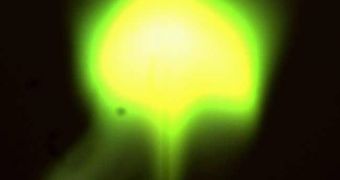There are many historical accounts of spherical lightnings, or "ball lightnings." Although they were once thought to be very rare, a 1960 paper reported that 5% of the US population reported having witnessed ball lightning and another study analyzed reports of 10,000 cases.
Ball lightning has the strange tendency to float (or hover) in the air and take on a ball-like appearance. Its shape has been described as either spherical, ovoid, teardrop, or rod-like with one dimension being much larger than the others. Many witnesses reported them as being red to yellow in color, sometimes transparent, and some containing radial filaments or sparks. Other colors, such as blue or white occur as well.
In the early 1960s, young Eddie Sines (who later became an electronic engineer) was watching a summer's day storm, while staying at his grandparents' house in Maryland, US. A lightning bolt struck a transformer on a telephone pole near the house, and he noticed a light-green luminous sphere, about the size of a tennis ball, suddenly appear on top of the transformer. It bounced off the transformer, then skirted along the underside of the cable that connected the pole to the house, came off at a dip in the cable and passed right through the window he was looking through. Finally, it hit the back wall of the room, where it made a small crackling sound and left bright trails of static electricity dancing all over the wall.
The strange ball lightning phenomenon, in which a fiery sphere floats through the air near the surface of the Earth, usually during a thunderstorm and ranging in diameter from a centimeter to a meter, is photographed very rarely, and details of witness accounts can vary widely. Many of the properties observed in ball lightning accounts conflict with each other, and it is very possible that several different phenomena are being incorrectly grouped together. It is also possible that some photos are fakes.
But 10,000 witnesses can't all have optical illusions, can they?
Recent laboratory experiments are just beginning to shed light on the nature of ball lightning, a phenomenon that has baffled scientists for centuries. Researchers at the Max Planck Institute for Plasma Physics and the Humboldt University, both in Berlin, have used underwater electrical discharges to generate luminous plasma clouds resembling ball lightning that last for nearly half a second and are up to 20 centimeters across.
The problem is ball lightning doesn't seem to obey physics laws as we know them. They float in mid-air, like they don't have any mass. This could be explained by the fact that lightning is made of pure energy.
But, electrical energy is not known to take spherical shapes, yet alone to exist in air, which has a poor electrical permittivity (it usually doesn't allow the passing of electricity trough it, or else we would all be electrocuted when passing by an electrical source). The "normal" lightning itself has a potential difference of millions of volts, that being the only possibility for electricity to "flow" through air.
And how do they go through materials like glass and continue on the other side, while they seem to vanish with a cracking sound when hitting walls? Could their short life be explained not by the fact that they encounter a specific density or matter composition, but rather by their internal mechanisms?
An early attempt to explain ball lightning was recorded by Nikola Tesla in 1904. As with modern popular hypothesis, he tried to explain the phenomenon as being a highly ionized plasma contained by self-generated magnetic fields, a plasmoid.
This hypothesis is not initially credible. If the gas is highly ionized, and if it is near thermodynamic equilibrium, then it must be very hot. Since it must be in pressure equilibrium with the surrounding air, it will be much lighter and hence float up rapidly. Magnetic fields, if present, might provide the plasmoid's coherence, but will not reduce this buoyancy. In addition, a hot plasma cannot persist for long because of recombination and heat conduction.
They could be made of some new form of plasma for which the present models do not apply, and probably composed of negative and positive ions, rather than electrons and positive ions. In that case, the recombination may be rather slow even at ambient temperature.
Other chemical compositions involve positively charged hydrogen and negatively charged nitrites and nitrates, where ions would be seeds for the condensation of water droplets.
A recently published experimental investigation of this effect by evaporating pure silicon with an electric arc reported producing "luminous balls with lifetime in the order of seconds", and videos of this experiment are available online.
Other, more esoteric explanations have been proposed, from ghosts and spirits to UFOs and energy beings from another world, but let's hope that physics will soon explain these mysterious encounters with more earthly tools.

 14 DAY TRIAL //
14 DAY TRIAL //